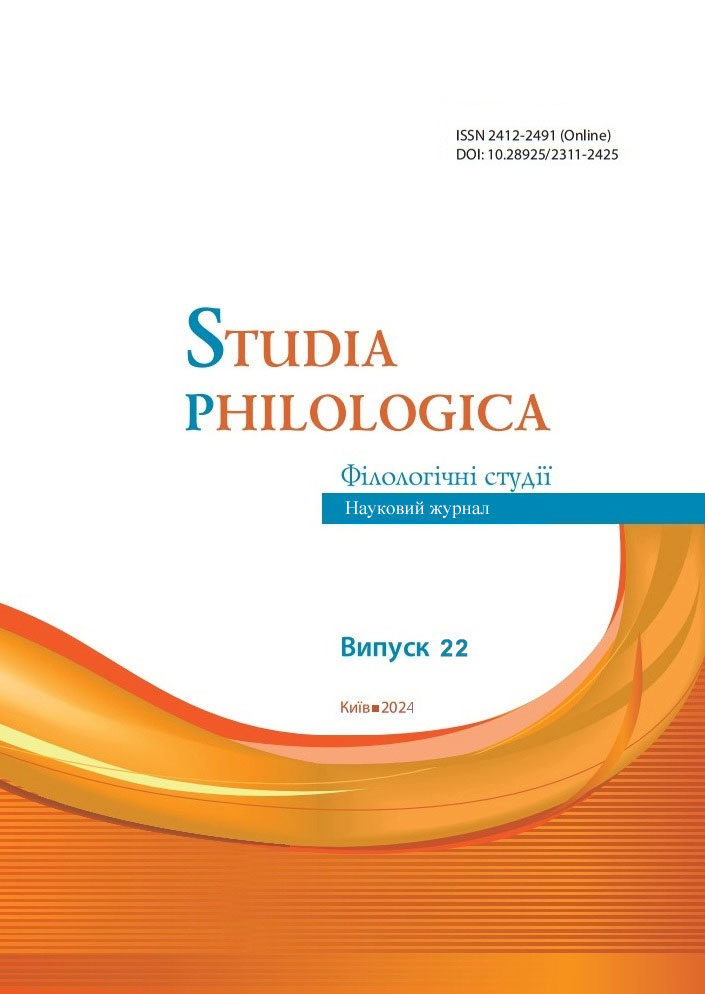“The New Woman” In Short Prose by Olga Kobylanska and Edith Wharton
DOI:
https://doi.org/10.28925/2412-2491.2024.2217Keywords:
New Woman; Olga Kobylanska; Edith Wharton; emancipation; marriage; maternity; freedom of choiceAbstract
The notion of the “new woman”, which emerged as a feminist ideal in Western consciousness during the late 19th century, resonates throughout both European and US-American literature. The main character in Olga Kobylanska’s novella “Eine Unzivilisierte” (1898) embodies the theme of female liberation in Ukrainian literature of the era. Similarly, the central female figures in Edith Wharton’s short stories, “The Other Two” (1902) and “The Mission of Jane” (1904), highlight the heightened role of women within the patriarchal society of the United States during that period. Applying close reading, block method and typological approach for the study of diachronic aspects of literary relationships the article analyzes the literary embodiment of the concept of “new woman” in short prose of Ukrainian and US-American women authors. In “Eine Unzivilisierte”, the protagonist Paraska actively opposes marrying a man chosen by others and is decisive in her own choice of partners; she does not feel any obligation to be a typical “housewife”, or to correspond to the typical picture of a woman, with all the activity connoted as typically “feminine”. Independent of her husband, the “new woman” at the turn of the centuries, Paraska proudly appeals to her right and ability to find another partner at any given moment. In contrast to Kobylanska’s novella Wharton’s short stories demonstrate rather submissive behavior of their central female characters, both named Alice. Maternity enables both Alices to subvert the established hierarchy achieving some freedom of “new woman”. In Kobylanska’s novella, the rural setting contrasts with the urban backdrop of Edith Wharton’s short stories, symbolizing the societal constraints faced by the “new woman”.
Downloads
References
Amos A., Haglund M. (2000). From social taboo to “torch of freedom”: the marketing of cigarettes to women. In: Tobacco Control; 9:3-8. DOI: http://dx.doi.org/10.1136/tc.9.1.3
Cooley, W. H. (1904).The New Womanhood. New York: Broadway Publishing Company.
Čyževs’kyj, D. (1997). A history of Ukrainian literature (from the 11th to the end of the 19th century). transl. by D. Ferguson, D. Gorsline, U. Petyk ; Luckyj George S. N. New York; Englewood: The Ukrainian Academy of Arts and Sciences ; Ukrainian Academic Press.
Erlich, G. C. (1992). The sexual education of Edith Wharton. Berkeley: University of California Press.
Heilmann, A., Beetham, M. (2004). Introduction. In New Woman Hybridities: Femininity, Feminism, and International Consumer Culture, 1880–1930 (p. 1-14). Introd. and ed. by M. Beetham & A. Heilmann. London and New York: Routledge. https://doi.org/10.4324/9780203643211
Hundorova, T. (2002). Femina Melancholica. Stat i kultura v gendernii utopii Olhy Kobylianskoi. Kyiv, Krytyka. 272 s. (in Ukrainian)
Hundorova, T. (2019). The Post-Chornobyl Library: Ukrainian Postmodernism of the 1990s. Transl. Sergiy Yakovenko. Boston: Academic Studies Press.
Kobylanska, O. (2013). Eine Unzivilisierte. In Valse mélancolique. Ausgewählte Prosa (S. 69-123). Czernowitz: Knyhy – XXI. (in German)
Köhler, A. (2004). The New Woman in American Cartoons. In New Woman Hybridities: Femininity, Feminism, and International Consumer Culture, 1880–1930 (p. 158-178). Introd. and ed. by M. Beetham, & A. Heilmann. London and New York: Routledge. https://doi.org/10.4324/9780203643211
Lavender, C. J. (1998). “Notes on New Womanhood”, prepared for students in HST 386: Women in the City, Department of History, The College of Staten Island/CUNY: https://csivc.csi.cuny.edu/history/files/lavender/386/newwoman.pdf
Patterson, M. (2008). The American New Woman Revisited: A Reader, 1894-1930. Ithaca, NY: Rutgers University Press: https://doi.org/10.36019/9780813544946
Richardson, A. (2004). The Birth of National Hygiene and Efficience: Women and Eugenics in Britain and America 1865-1915 (p. 240-262). In New Woman Hybridities: Femininity, Feminism, and International Consumer Culture, 1880–1930 (p. 158-178). Introd. and ed. by M. Beetham, & A. Heilmann. London and New York: Routledge. https://doi.org/10.4324/9780203643211
Ryan, M. P. (1979). Womanhood in America. New York: New Viewpoints. A Division of Franklin Watts.
Rymarchuk, T.F. (2004). Nitssheanstvo, idealizm, hender neoromantychnoho heroia v tvorakh O.Kobylianskoi ta E.Uorton. In: Typolohiia ukrainskoi ta amerykanskoi literature (s. 43-64). Kyiv: Vydavnycho-polihrafichnyi tsentr «Kyivskyi universytet». (in Ukrainian)
Shkandrij, M. (2015). Ukrainian Nationalism: Politics, Ideology, and Literature, 1929-1956. Yale University Press.
Singley, C. J. (1998). Edith Wharton: matters of mind and spirit. Cambridge University Press.
Wharton, E. (1991). The selected short stories. Introd. and ed. by R. W. B. Lewis (Ed. Lewis, R.W.B). New York, Toronto, New York: C. Scribner’s Sons.
Published
How to Cite
Issue
Section
License
Copyright (c) 2024 CC BY 4.0 DEED Attribution 4.0 International

This work is licensed under a Creative Commons Attribution 4.0 International License.


